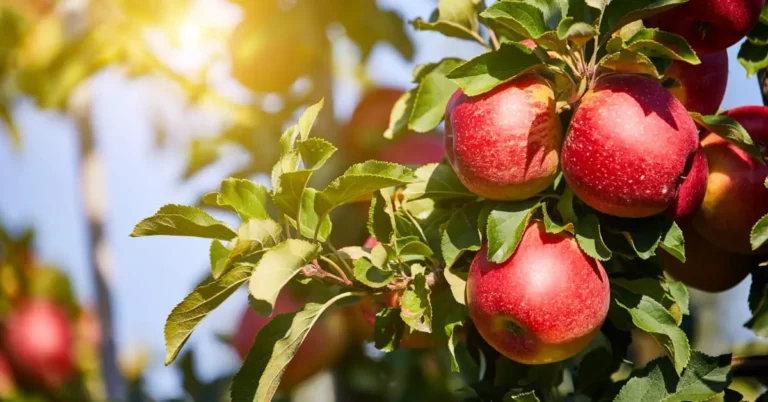25 Best Red Fruits To Add in Your Diet
Are you curious about the colorful world of fruits and how they can add flavor to your healthy diet? Here are 25 red fruits ( fruits that are red) that delight your taste buds and are packed with unique flavors and health benefits. You will enjoy exploring the delicious world of red fruits whether you are a food enthusiast or simply looking to add flavor to your meals. What are you waiting for? Let’s begin!

How Do Red Fruits Get Their Color?
Anthocyanins are the chemicals responsible for the red color in fruits. The color of anthocyanins can vary depending on the pH of the fruit’s cells.
Acidic conditions turn anthocyanins red, while neutral or alkaline conditions turn blue or purple. Because this color change depends on pH, red fruits may look different in different situations.
Additionally, anthocyanins give red fruits their bright color and antioxidant qualities. Red fruits (fruits that are red) have compounds that may be good for your health. These compounds have anti-inflammatory and anti-cancer qualities, which makes them look good and be good for you.
Benefits Of Red Fruits:
Here is a graph showing red fruits’ nutritional value and health benefits.

List Of 25 Red Fruits (FRUITS That are RED)
The best red fruits for your health are listed below:
1. Strawberries:
Strawberry is one of the most popular red fruits. Strawberries are delicious, juicy, and full of good nutrients. These red gems contain a lot of vitamin C, manganese, and antioxidants. These are good for your heart, defense against illness, and skin.

2. Cherries:
Another red delight is cherries, whether they are sweet or tart. Delightful cherries are a nutritionally dense food rich in anthocyanins, potassium, and fiber.
They are also rich in polyphenols and vitamin C sources, which have antioxidant and anti-inflammatory properties.
You can add pitted and halved cherries to green salads or grain salads to enhance their sweetness. You can add cherries to your favorite smoothie to make it sweeter and more colorful.
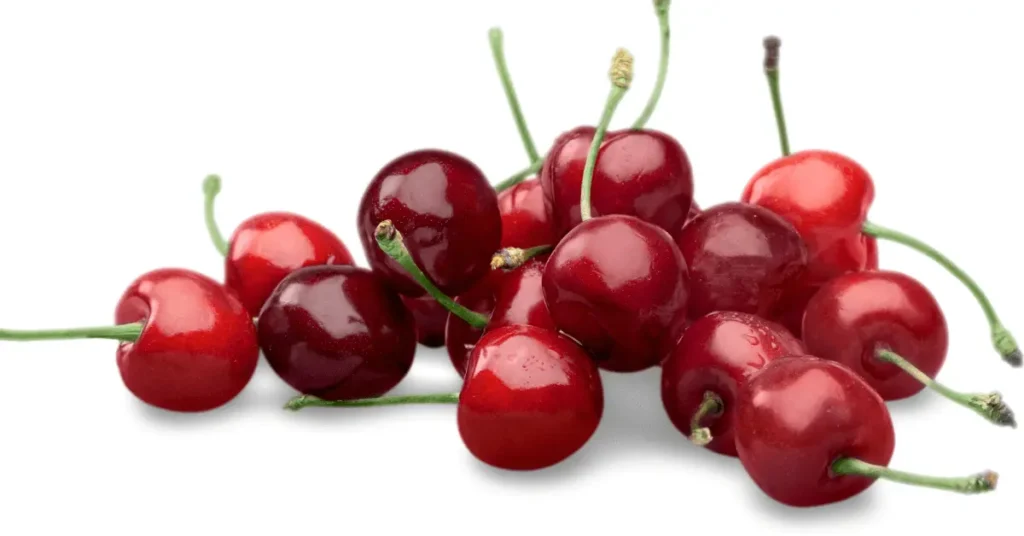
3. Raspberries:
Raspberries are an excellent addition to any fruit salad because of their unique flavor and vibrant red color. Raspberries are a rich source of vitamin C, manganese and dietary fiber, but they have a low content of micronutrients.
Raspberries are a low-glycemic index food, with a total sugar content of only 4% and no starch. Sprinkle fresh raspberries to add sweetness and texture to your morning oatmeal or cereal.

4. Red Apples:
Apples, such as Fuji and Red Delicious, are known for their sweetness and crispness, although apples come in various colors. Apples are a great source of dietary fiber and can aid in weight loss and improving digestive health. Additionally, they contain antioxidants like quercetin, which may have heart-protective and anti-inflammatory qualities.

5. Pomegranates:
The red color and numerous health benefits earn pomegranates the title of “jewels” in the fruit world. Because of their high antioxidant content, people recognize pomegranates for their heart-protective and anti-inflammatory properties.
Many dishes incorporate or juice the seeds, adding flavor and nutrient density. You can add pomegranates to your diet both for flavor and nutrition.

6. Cranberries:
As fresh cranberries are hard, sour, and bitter, about 95% are processed and used to make cranberry juice and sauce. Cranberry juice is usually sweetened or blended with other fruit juices to reduce its natural tartness. In particular, these berries are known for preventing urinary tract infections (UTIs) and supporting overall urinary health.

7. Watermelon:
Watermelon (Citrullus lanatus) is a flowering plant species of the Cucurbitaceae family, and the name of its edible fruit. With its luscious pink-red flesh and juicy nature, watermelon is a delightful addition to any summer spread.
Consumption of watermelon provides long-term health benefits such as reduced risk of heart disease, improved blood pressure in hypertension patients, and a cardio-protective effect.

8. Red grapes:
It is not just the vibrant crimson color of red grapes that makes them visually appealing, but also their high content of antioxidants. Red grapes improve heart health, lower blood pressure, and lower cholesterol. Adding red grapes to your diet can have many health benefits, including promoting cardiovascular health.

9. Red Currants:
These little red berries are like nature’s rubies, adorning bushes with bright red clusters of berries. Their small size and jewel-like nature make them stand out among berries. Red currants are high in dietary fiber and essential for digestive health.
Fiber promotes regular bowel movements, prevents constipation, and supports a healthy gut microbiome. You can increase your fiber intake by including red currants in your diet.
You can make red currant juice or add them to your favorite summer drinks. For a refreshing taste, infuse water with red currants.

10. Dragon Fruit:
The dragon fruit, also known as pitaya or pitahaya, is a visually stunning tropical fruit from the cactus family. One type of dragon fruit has pink or red skin and white flesh; the other has yellow skin and white or red meat. Dragons have scales on their outer skin, whose inner flesh is soft, subtly sweet, and sprinkled with tiny black seeds.
There are two essential B vitamins in dragon fruit: B1 and B3. Minerals such as iron, magnesium, and phosphorus contribute to bone health.
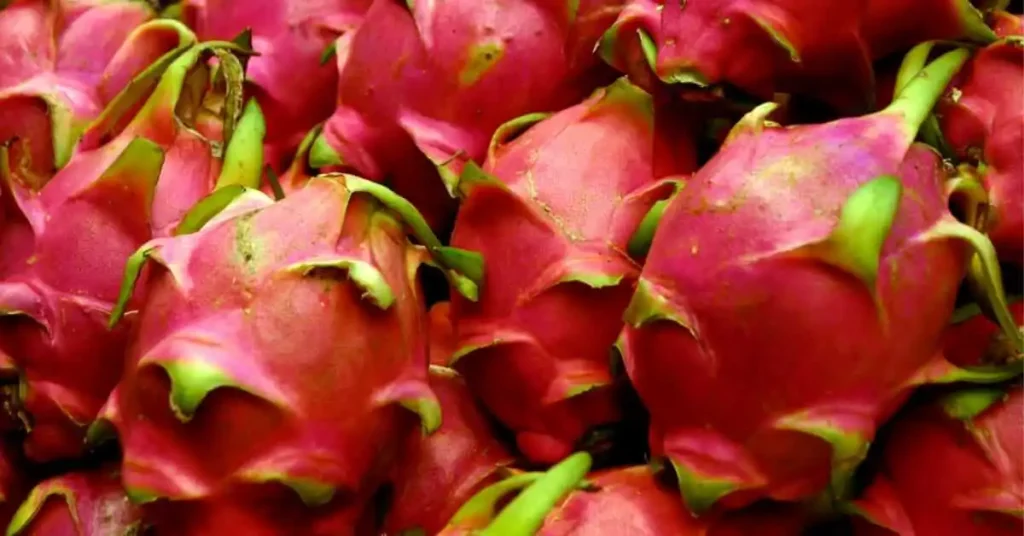
11. Red Plum:
Red plums have smooth, shiny skin and are small, round, or oval. In general, the flesh of these fruits is pale yellow or red when you cut into it, and it has a sweet and juicy taste. Red plums, like many red fruits, contain antioxidants. Compounds such as vitamins C and A lower the risk of chronic diseases and promote overall health by combating oxidative stress in the body.
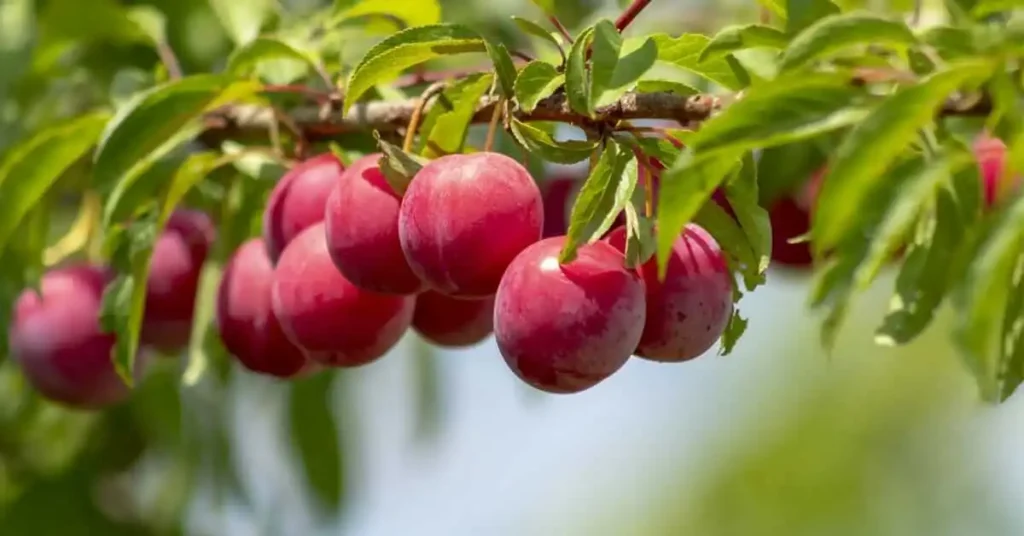
12. Red Nectarines:
The red nectarines resemble a peach, but the skin is smooth. You’ll find juicy, sweet, and flavorful flesh when you bite into them. The skin of red nectarines is smooth, whereas peaches have fuzzy skin.
In addition to providing a sense of fullness, red nectarines provide dietary fiber that aids digestion, promotes bowel regularity, and aids digestion. For those who are watching their calorie intake, they make a nutritional and satisfying snack.

13. Red Mulberries:
Red mulberries are small, cylindrical fruits ranging from deep red to almost black when fully ripe. Red mulberries often have a sweet and mildly tart flavor, sometimes resembling black and raspberries.
Depending on their ripeness, mulberries taste sweeter when fully ripe. Vitamin C, vitamin K, iron, potassium, dietary fiber, and vitamin K are all found in these berries. Vitamin C aids the immune system, while vitamin K aids blood clotting. Mulberries contain dietary fiber, which promotes digestive health and regular bowel movements.

14. Red Banana:
Red bananas are smaller than the standard yellow bananas, and their skin is typically a deep maroon or reddish-purple color. The flesh inside is a pale pink to salmon color.
Red bananas have a sweet flavor, often described as a combination of berries and traditional yellow bananas. The texture is creamy and softer than that of yellow bananas.

15. Red Mango:
Red mangoes could refer to various mangoes with red or reddish skin when ripe. Mangoes are tropical fruits known for their sweet and juicy flesh. Different types of mangoes can have varying skin colors, including shades of red. Various antioxidants in red mangoes reduce oxidative stress and inflammation in the body.

16. Red Passion fruits:
Red passion fruit, scientifically known as Passiflora edulis var. edulis, is a tropical fruit with a vibrant red or purple outer shell and a unique, aromatic flavor. Red passion fruits typically have a round to oval shape. The outer skin is smooth and waxy, with a deep red or purple color when ripe.
The interior contains juicy, gelatinous pulp filled with black seeds. Red passion fruit has a distinctive sweet-tart, refreshing, and tropical flavor. The pulp contains dietary fiber, promoting digestive health and feeling full. The fruit is a good source of vitamin A, essential for vision and immune function.
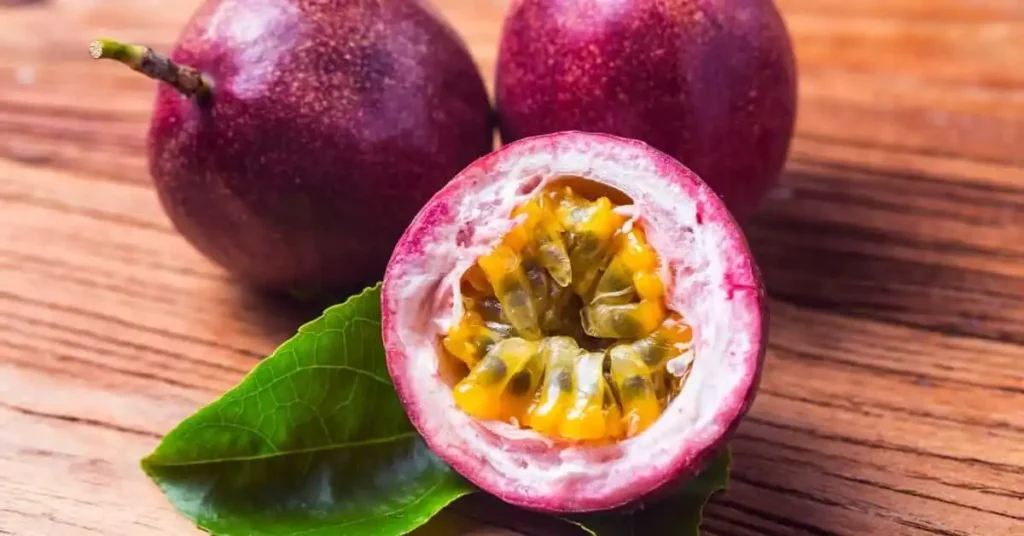
17. Red prickly pear:
The red prickly pear, scientifically known as Opuntia ficus-indica or more commonly referred to as red cactus pear, is a type of cactus that produces distinctive, red fruits.
The fruit is oval or pear-shaped and covered in tiny, hair-like prickles. The skin of red prickly pears is typically a vibrant red or magenta color, though shades may vary. Red prickly pears have a sweet and mildly tangy flavor.

18. Rambutan:
Rambutan (Nephelium lappaceum) is a tropical fruit known for its distinctive appearance and sweet, juicy taste. Rambutan has a round or oval shape, similar to a lychee.
The skin is hairy or spiky, and it can range in color from red to yellow or orange, depending on the variety. The flesh inside is translucent and has a white or pale pink color. The flesh of the rambutan is juicy, sweet, and mildly acidic. It has a texture similar to grapes but with a larger seed in the center.
19. Blood Orange (Citrus Fruit):
Blood oranges (Citrus sinensis) are a unique and visually striking variety of oranges known for their distinct deep red or burgundy-colored flesh. Blood oranges are medium-sized citrus fruits with an external appearance similar to common oranges. Blood oranges are sweet and slightly tart, often with berry-like undertones.

20. Red Grapefruit:
Red grapefruit has a yellow to yellow-orange outer skin with a characteristic blush or deep red pigmentation in the flesh. The intensity of the red color can vary among different varieties. It has a sweet-tart flavor with a slightly bitter undertone.
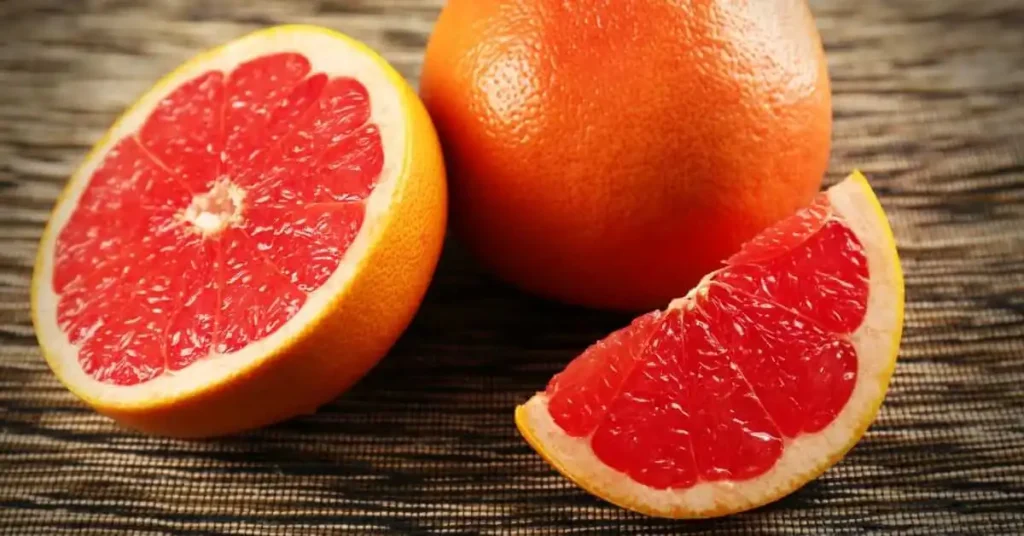
21. Goji Berries:
Goji berries, also known as wolfberries, are small, red-orange berries that resemble raisins when dried. You will eat both fresh and dried. It has a sweet and slightly tangy taste. Goji berries are rich in antioxidants, including beta-carotene and zeaxanthin, which are beneficial for eye health. They contain vitamins and minerals such as C, A, iron, and zinc. Goji berries are a good source of fiber, promoting digestive health.
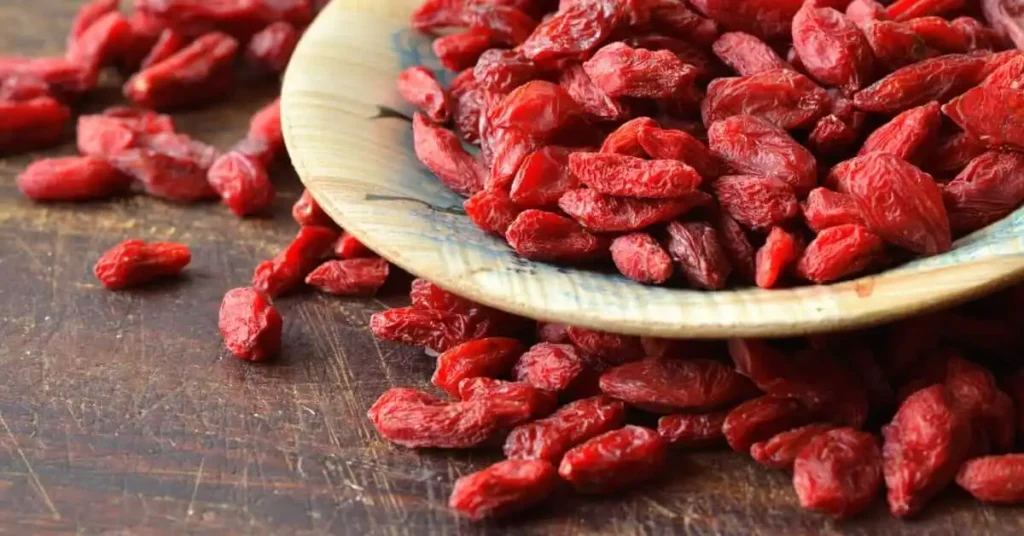
22. Red Tamarillo:
Red tamarillo, or tree tomato, is a tropical fruit with vibrant red or orange skin and a unique egg-like shape. The skin is smooth and shiny, ranging from bright red to orange. The flesh inside can vary from orange to deep red, depending on the variety. Red tamarillos are rich in vitamins and minerals, including C, A, and potassium. They contain antioxidants that contribute to overall health.

23. Lingonberry:
Lingonberries are small, round berries, typically 6-10 mm long. They have a bright red color and are similar in appearance to cranberries. Lingonberries are rich in vitamins, particularly vitamin C, and contain antioxidants that benefit their health. They also provide dietary fiber and various minerals.

24. Red Pitanga:
Red Pitanga, or Surinam Cherry or Brazilian Cherry, is a tropical fruit native to South America. Typically small, about the size of a cherry or slightly larger. Depending on the variety, it ranges from bright red to deep red when ripe. The presence of antioxidants may contribute to health benefits. Contributes to meeting daily vitamin C requirements.

25. Red Jabuticaba:
The fruit is small, typically about the size of a grape, and has a dark red to almost black color when ripe. It has a thick, tough skin containing a sweet, gelatinous pulp with a unique taste that blends grape, lychee, and rose. Red Jabuticaba is not only valued for its unique appearance but also for its nutritional content, including:
Rich in antioxidants that help combat oxidative stress in the body. It contains various vitamins, including vitamin C, essential for immune function. Provides necessary minerals such as potassium and magnesium.
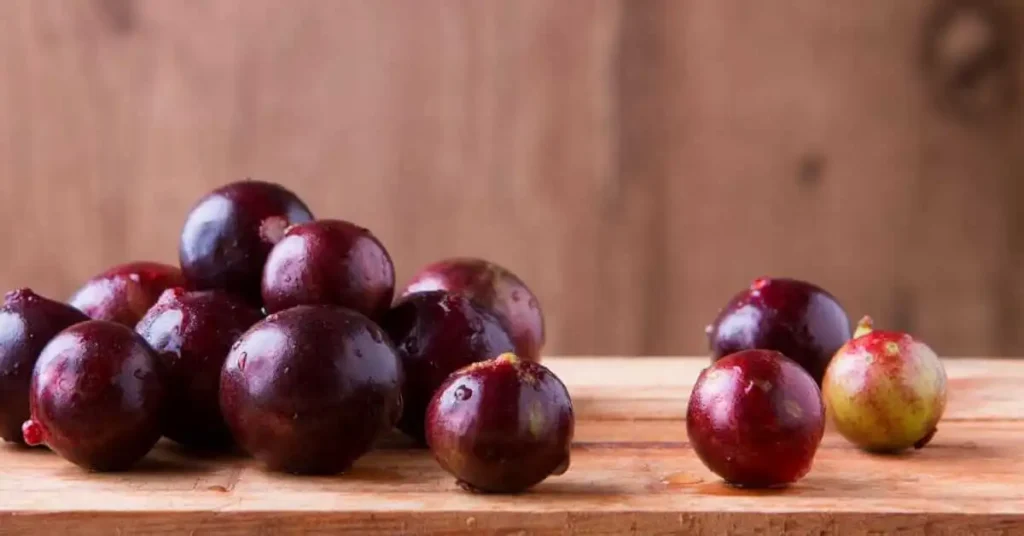
What are the best ways to include red fruits in our diet?
Consuming red fruits is a delicious and nutritional way to enhance your diet. Here are a few ways to enjoy them:
1. Fresh Snacking:
Grab a handful of red berries, cherries, or grapes for a quick and healthy snack. Not only are they delicious, but they also contain vitamins and antioxidants.
2. Smoothie Boost:
Add red fruits like strawberries, raspberries, or pomegranate seeds to your morning smoothies to give them additional nutrients and flavor.
3. Homemade Salsa:
You can make a simple salsa with diced tomatoes, strawberries, and lime juice. It is ideal for topping tacos, grilled chicken, and fish.
4. Infused Water:
Make your water refreshing and hydrating by adding slices of red fruits such as strawberries or watermelon.
Conclusion:
In conclusion, red fruits (fruits that are red) are visually appealing and nutrient-dense due to their pigments called anthocyanins. Acidic conditions turn these pigments red, giving strawberries, cherries, and apples their vibrant colors. Additionally, they offer health benefits due to their antioxidant content, such as reducing inflammation and potentially preventing certain diseases. They contain nutrients and color, offering various flavors and health advantages.



